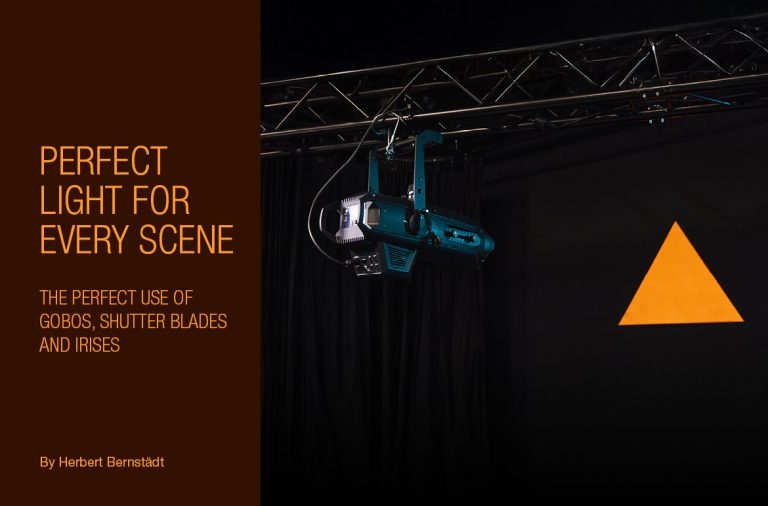LD Systems MAUI 5 GO – Test Report by Gitarist
A compact sound system with integrated li-ion battery: is the MAUI 5 GO the solution for small gigs when no other power source is available?
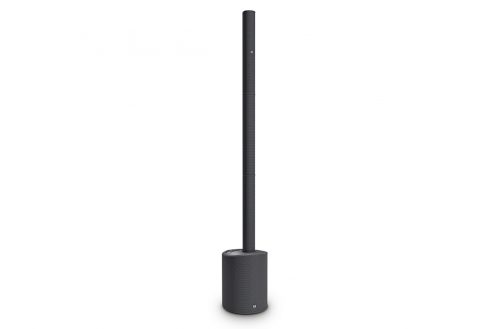
The MAUI 5 GO consists of a basic module and three columns that are placed on the base with multi-pin connectors. The first column contains the battery (also available separately, so you can quickly replace it when it is empty), which according to the specs lasts six to twenty hours, depending on the volume.
In the second column, we find four 3-inch mid/high speakers, and then there is an extension module to use the mid/high speakers at two different heights. The basic module contains the Class D amplifier, connections, controllers and an 8-inch woofer for the bass. The inputs: a mic/line input (xlr-jack-combo), an instrument input (jack) and an extra stereo input (mini-jack) for the music during the break. The stereo input can also be played via Bluetooth. Each input has its own potentiometer – the combo-input even has two. We also see a master and two volume controls: for sub and hi-boost.
Several control LEDs, a mono/stereo switch (when using a second MAUI 5 GO – there is an xlr-on-connection for this is on the back) and a Bluetooth switch complete round everything off
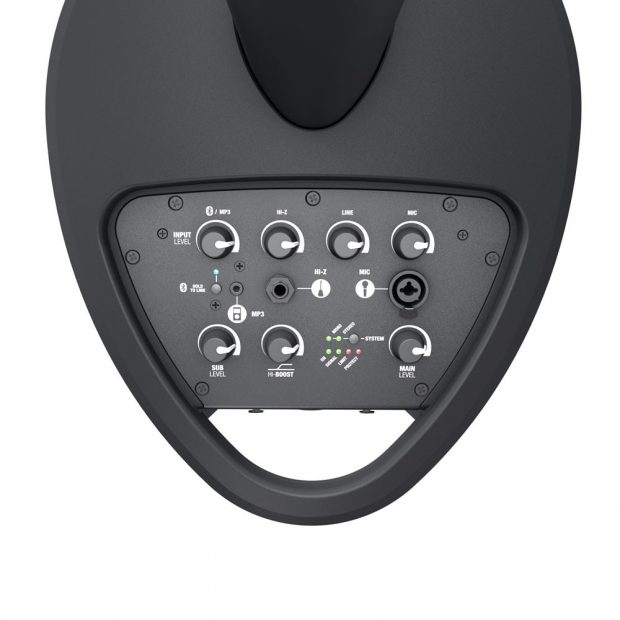
Solid
All of the plastic elements have a metal grille and make a good impression. The basic module is a solid block in which the potentiometers are firmly attached and on which the columns are easy to mount. The whole thing is set up within just a minute. A striking feature is its low total weight (12.9 kg), which makes the MAUI 5 GO easy to handle and can be transported by one person.
Time to turn it on.
You have to do this while the device is connected to the external power supply with the mains cable, because the battery is still empty, as can be seen from the indicator LEDs in the first column. Let’s start out carefully, and put on a little bit of music. The MAUI 5 GO’s Bluetooth receiver is easily recognised by my iPhone and when you turn up the volume, the room slowly fills up with my playlist, which naturally contains different music styles.
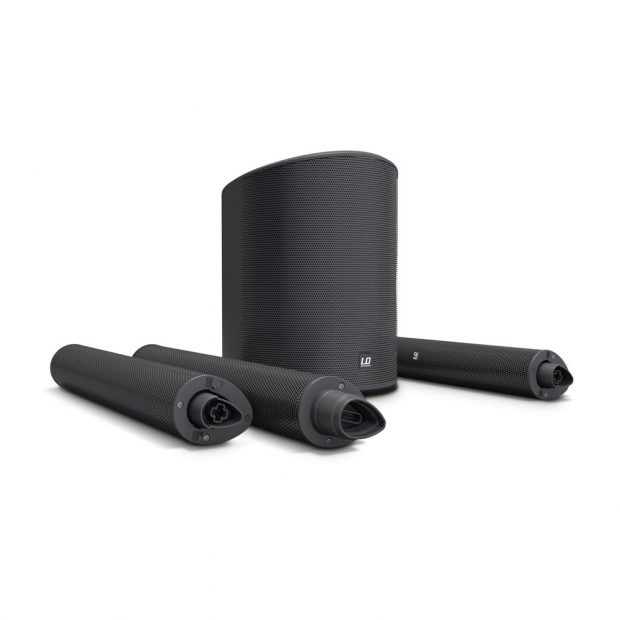
A Pleasant Surprise
The MAUI 5 GO sounds remarkably neutral. Digital signal processing (DSP) actually consists of just one fixed preset, in which the EQ, crossover, limiter and compressor settings are pre-configured. So, you can adjust almost no settings at all, but that makes it even easier to use. And above all: the settings of the DSP are well chosen. I’m pleasantly surprised by the lack of that specific, ‘modern’, overstrained high that the mp3 era has endowed upon us. The mid region is very defined.
The low region is a bit discreet, but we have the sub-level button for that. When we turn it up, it renders a pleasant rounded bass to the sound, but half way through the sound starts to become very full. For my taste it gets a bit too much too quickly. For some extra freshness in the high region, you have the hi-boost, which adds the desired clarity starting from about 8 kHz. Here too: less is more.
Another remarkable thing: the MAUI 5 GO is pretty loud! And almost without any distortion. Its middle and high regions are together actuallya small line array and when I walk through the room, it easily reaches the 120-degree range, which the specs claim it does.
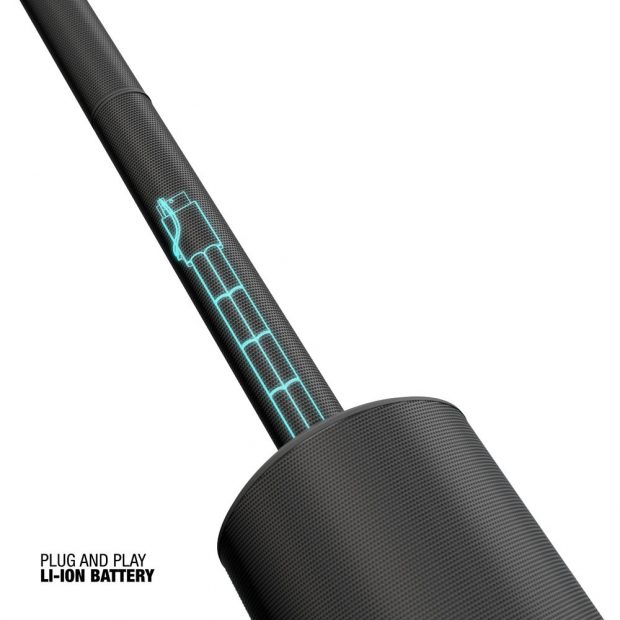
Effortless
My playlist sounds fine, but we are especially curious about how the MAUI 5 GO fares with live music.
Because I am first and foremost a sound technician and don’t play any melodic instruments, I picked up singer-songwriter Levi from the rehearsal room. While she gets her acoustic guitar set up, I connect the microphone.
This is a dynamic Shure SM58, because the MAUI 5 GO doesn’t do phantom power. With the volume turned up, I walk with the microphone in my hand carefully up to the front of the speaker, where I am truly surprised: no feedback, not even a hint!
All I hear is my own voice, without any annoying bleeps (by the built-in low-pass filter below 100 Hz) and without any strange extra ringing in the high-mid regions. When I speak into the microphone very close to my mouth, I hear a small burst at 315 Hz, but at a few centimetres distance it disappears again.
Meanwhile the guitar is plugged in and the input potentiometer seems to render the volume quite enthusiastically.
But without hesitation, the MAUI 5 GO immediately goes into protect mode. So, security seems to be working fine! The acoustic guitar sounds, well, like an acoustic guitar. That means no irritating rattling in the high-mid region or annoying banging in the low region. When playing some songs – we’ve now been playing for quite a while on battery power – it appears that it effortlessly mixes the guitar and voice into a whole, with enough room for both instruments. “Very fine, very natural sound”, says Levi. She wants to know if there’s a reverb on it. Well, no actually. We will have to do without it.

On the Road!
The LD Systems MAUI 5 GO is not for everyone. You wouldn’t want to mix a tape on it, although you could do that with the stereo xlr inputs on the back and an external mixer, but then you are actually ignoring the essential advantages of this system.
You could hold a modest rave with it on the beach, but the MAUI 5 GO is extremely suitable for an acoustic solo artist or duo, who with this well-designed, idiot-proof, beautifully sounding set will have no need of extensive transport, space-hungry equipment and technical assistance. At any place, power or not, I’d put you on the road with it. If you need, take a reverb box along with you.

Gitarists verdict
Gitarist says: Great mini-PA for acoustic solo artists or duos. You do have to connect an external reverb
LD SYSTEMS MAUI 5 GO
Type: battery-operated mini PA
Amplifier: Class D, 200 watts (RMS), 800 watts (peak)
Max. sound pressure level (SPL): 120 dB
Frequency response: 50 Hz – 20 kHz
AD/DA-conversion DSP: 24 Bit/48 kHz
Woofer: 8 Zoll
Mid-/High speakers: 4 x 3 Zoll mit 1-Zoll Schwingspule
Regulation: main level, sub level, hi-boost, mic, hi-Z, Line, MP3/Bluetooth link, on/off, mono-/stereoswitch, on/off switch
Connections: 2x xlr- input, xlr/jack output, mini-jack input, hi-Z-jack input, xlr-system out, power cord
Battery: LG Chem Lithium-Ion
Charging time: 2 hours up to 80 percent, 3 hours up to 100 percent
Battery life: 6 hours at 120 dB, 10 hours at 104 dB, 20 hours at 98 dB
Extra accessories:
Spare battery, charging dock, cover for subwoofer, carrying bag
Weight: 12.9 kg
Total hight: 198.5 cm
Website: ld-systems.com
————————————————————————————————————————————-
Author: Martin Zijlema
Gitarist | Gitarist.nl/MAUI5GO




